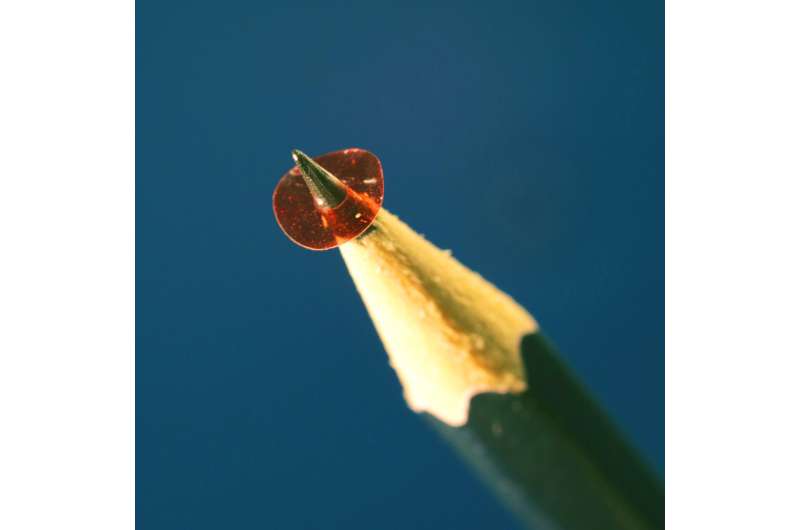Photo of the 5.5 mm diameter micromotor rotor made of specially oriented polymer film, on a pencil tip. Credit: UW Physics, Piotr Wasylczyk
Researchers at the Faculty of Physics at the University of Warsaw, with colleagues from Poland and China used liquid crystal elastomer technology to demonstrate a rotary micromotor powered with light. The 5-millimeter diameter ring, driven and controlled by a laser beam, can rotate and perform work, e.g. by rotating another element installed on the same axis.
Rotational movement in nature is very rare, while at the same time ubiquitous in our civilization. While we can build a variety of rotary motors, they usually consist of many elements and it makes their miniaturization difficult. However, there is a group of materials that enable construction of small, moving and/or mobile devices—liquid crystal elastomers (LCEs). Research on these materials focuses mainly on design of LCE shapes and its change upon laser illumination (e.g. shrinking, bending).
Liquid crystal elastomers are smart materials that can exhibit macroscopic, fast, reversible shape change under different stimuli, including illumination with visible light. They can be fabricated in various forms in the micro- and millimeter scales and, by the molecular orientation engineering, they can perform complex modes of actuation.
Researcher from the University of Warsaw with colleagues from the Department of Mathematical Sciences at Xi'an Jiaotong-Liverpool University in Suzhou, China; Institute of Applied Physics at Military University of Technology in Warsaw; and Centre of Polymer and Carbon Materials of Polish Academy of Science in Zabrze, Poland, have now developed a micromotor that rotates thanks to the traveling deformation of the soft material, caused by the laser beam and its interaction with the ground. The main part—the rotor—is a 5 millimeter ring. Appropriate design of the orientation of the elastomer molecules provides stable performance of the micromotor or can increase the rotation speed.
A movie of the 5.5 mm diameter micromotor, driven by a rotating laser beam. Credit: UW Physics, Mikolaj Rogoz
"Despite low speed, around one rotation per minute, our motor allows us to look at the micromechanics of intelligent soft materials from a different perspective and gives food for thought when it comes to their potential use," says Dr. Klaudia Dradrach from the Photonic Nanostructure Facility. The motor design has been inspired by ring piezoelectric motors, often found in autofocus mechanisms of photographic lenses. The contribution of scientists from the Polish Academy of Sciences in Zabrze and the Military University of Technology was crucial to the development of the method of reproducible fabrication of LCE miniature components. Notably, young researchers took part in the study, including Mikolaj Rogoz and Przemyslaw Grabowski, Ph.D. students from the Faculty of Physics of the University of Warsaw.
Researchers who have previously demonstrated a light-powered snail robot moving like its natural relatives believe that new intelligent materials combined with advanced fabrication methods will allow them to build further miniature components and drives.
More information: Klaudia Dradrach et al, Traveling Wave Rotary Micromotor Based on a Photomechanical Response in Liquid Crystal Polymer Networks, ACS Applied Materials & Interfaces (2020). DOI: 10.1021/acsami.9b20309
Journal information: ACS Applied Materials and Interfaces
Provided by University of Warsaw
























